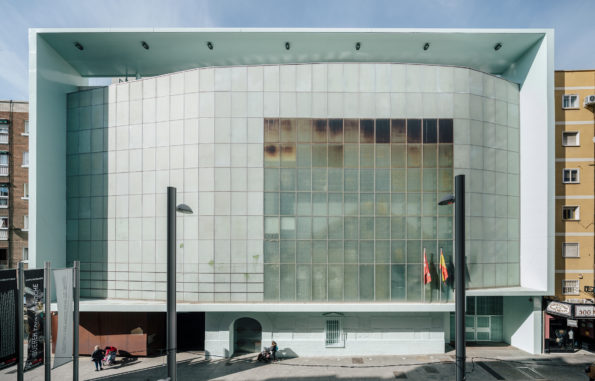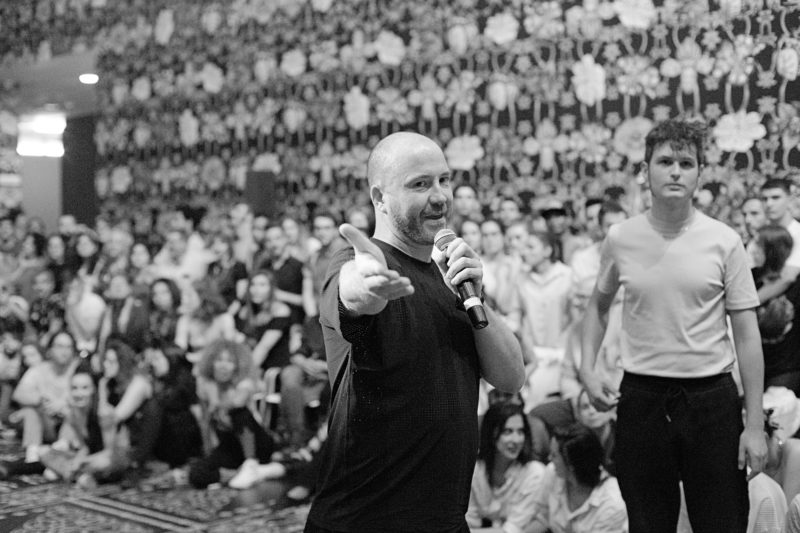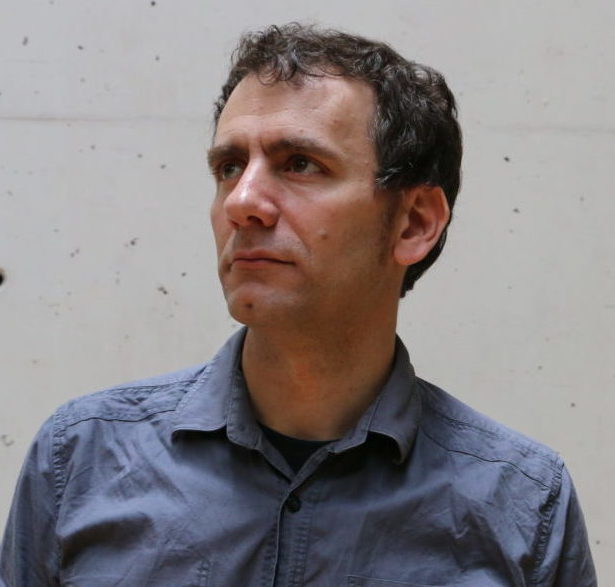Search
To search for an exact match, type the word or phrase you want in quotation marks.
A*DESK has been offering since 2002 contents about criticism and contemporary art. A*DESK has become consolidated thanks to all those who have believed in the project, all those who have followed us, debating, participating and collaborating. Many people have collaborated with A*DESK, and continue to do so. Their efforts, knowledge and belief in the project are what make it grow internationally. At A*DESK we have also generated work for over one hundred professionals in culture, from small collaborations with reviews and classes, to more prolonged and intense collaborations.
At A*DESK we believe in the need for free and universal access to culture and knowledge. We want to carry on being independent, remaining open to more ideas and opinions. If you believe in A*DESK, we need your backing to be able to continue. You can now participate in the project by supporting it. You can choose how much you want to contribute to the project.
You can decide how much you want to bring to the project.

Manuel Segade is the director of CA2M (Centro de Arte Dos de Mayo) in Móstoles, Madrid. Before that, he was the chief curator of the CGAC (Centro Galego de Arte Contemporánea) as well as the coordinator of Metrònom – Fundació Rafael Tous in Barcelona. His curatorial work blends the historical approach with the thought around the building of the body and social redefinition. Segade was the curator of the Spanish pavilion in the Venice Biennale (2017).
MM: It will soon be 5 years since you were named the director of CA2M, time just flies by. For some seasons now, you’ve been defining operational modes mixing curatorial investigation and formats that connect several generations, local context and international information from the institution. The definition of what an artistic institution with a public function is, is probably found in the crossroad of operational modes.
MS: Exactly. Public interest is part of the dictionary meaning of the word “institution”. If we think about how to promote public interest on contemporary art, we also should depart from its definition. It’s a term that agglutinates artistic productions that belong to the contemporary regimen, which emerged in the 60’s as a cultural manifestation with a conceptual basis that was institutionally critical, with a self-conscious language that promoted fluid or multiple notions of identity. That is to say, an interseccional root that includes feminism and de-colonial notions, with a will of social transversality that crosses social classes. With this, I’m trying to say that the crossroad in which the institutional matters in our fields is today is that of serving its foundational principles: the advocacy of public interest in contemporary art is in its collective legitimacy and in the demonstration of its relevance.
When it comes to operational modes in CA2M Centro de Arte Dos de Mayo, bodies and investigation are present everywhere. Even before the outbreak of the COVID-19 —the common use of a scientific name as a fantasy of collective power fascinates me. It’s like a projection of the future control that technic knowledge will have over the virus, when in actuality, it is just a more or less random result of our anthropocenic effect— neoliberalism already forced any member of citizenry to use tools of investigation simply to survive.
A basic example of this, is to think how the decision making can no longer be detached from the access to information through mobile devices. Today, the investigative demand affects all social levels, which places us all in the same level, because my dad, my neighbours, and the owner of the off-licence that’s in front of my house must now apply different processes of intensive investigation in order to survive. That’s why all forms of life in our society and the operational modes in museums have to be understood as narrative chains in a succession of practical, overlapping and contiguous roles at the same time. Bodies are where it all happens/ everything happens. Performativity is the quality of language that allows it to sanction what’s real, that it has affects things. When it’s applied to bodies, performativity is necessarily what bonds any possible body —intersectional by institutional nature— to the material culture that museums shelter, but that they represent in themselves. What’s local is no given place, but rather the context that is produced from the friction of those bodies that are both subjects and objects of investigation at the same time. And, therefore, also objects of pleasure and forms of life x.
MM: Bodies and institutionality. If we make a fast tour through institutional critique, we can see antagonistic positions first —that allow a definition “from outside” of the part related to the power of the institution— to jump to a critical work from inside afterwards. But the “inside” is something almost architectonical and agglutinative. I think you are closer to a stance of multiplicity of bodies that bring us to a different type of definition of what’s institutional, rather than something that’s conscious of its own existence through the performativity of a variability of bodies.
MS: The body of the institution is a body with a choral voice or “Legion”, like the one who was possessed in the Bible. If we assume contemporary art as that exercise of language that performs what’s real and whose representational effects produce subjectivities… The institution must be that space for identities in transit. In CA2M, we have tried to think of it, not in a metaphorical way, but rather as a gestural repertoire. We have been thinking a lot about how the term “social choreography” summarises best, not what this museum is, but rather what happens to us in it. A museum that’s understood as the space of essay or cultural transit of those choreographies is that museum that serves all the gestures that arrive as potential choreographic phrases, common potential to build. In other words: it’s that museum where every body fits, and it’s those bodies the ones that think, talk to each other and have a meaning.
What’s hard for an institution is to assume that level of in-definition: to go from building itself departing from the identity of a building, of a program, of a tendency, of a theme, to standing up departing from a framework, some forms of care*, some methodologies of investigation and some forms of moving. In what you’re asking, acupuncture is very emblematic, to take away the pain of the building, which we undertake with Andrés Jaque and his Office for Political Innovation. In each phase, this exposition of architecture is the performance of the building making itself, but it also implies making the building dance. Lately, Plato’s Chariot Allegory comes to my mind very often: through his rational intelligence the charioteer guides on one hand an ethical and perfect horse, immobile and beautiful, not submitted to any emotion and that drives itself with astonishing effectivity; and on the other hand, he guides a pathetic, difficult, changing being that is subjected to any type of affection, a horse that rears, behaves unexpectedly and is probably doomed to failure. A building like the one Andrés is conceiving, whose architectonical nature are its possibilities for collective use, and therefore its institutional capacities of social transformation, has more to do with that second horse. It’s no surprise that in the platonic narrative, the second horse is described as “black”.
MM: It’s not the first time I’ve heard you talking about the CA2M as a “museum”. I wonder if that consists of a system made to fortify the institution, since a museum has a presupposed historical longevity and a function that detaches it from political tinkering. It is also interesting to think that the highest institution in Spain —Reina Sofía— uses both concepts (Museum and Art Centre) in its official name. What do you think this duality of functions is due to?
MS: Foundationally, CA2M shares this duality: it was baptised as Museo Centro de Arte Dos de Mayo. At some point, however, it lost the “Museum” in its website, in its common name, in its logotype… Its function as a museum is obvious: it contains not only one, but two collections —Colección CA2M and Colección Fundación ARCO— that amount to more than three thousand pieces that we take care of in order to exhibit them publicly in our own expositions or in foreign ones, and also in investigations and texts in and outside CA2M. At the same time, it has always responded to the functions of an art centre, with temporary expositions and a huge quantity of activities and experimental educational programs. I find this debate interesting for a reason that I already explained before: if a museum is a contemporary art museum, that overlapping of diverse activities —and even contradictory activities—, that contrast between the narrative of a museum as a strong institution and the changing weaknesses of its ephemeral programs, or in other words, the chorality or choreographic form of its narrative and its capacity of continuous transformation shouldn’t be surprising to us, but rather become part of its definition.
MM: In a certain way, we are talking of the construction of history from two points of view.
MS: An art museum has the material artistic culture and the discipline born to organise its narrative in the history of art as goals. But what happens with the contemporary art museum? Sometimes its goal is the anti-material, it focuses in processes rather than results, it exists as a position of speech rather than a form of direct and effective communication… It necessarily has to result in many other histories of art, critiques, open and changing ones. If we reappropiate the derogatory adjectives directed at contemporary art by the people who criticise it or despise it, we could define these histories of art as obscure, ground-breaking, toxic, opaque, mongrel, baseless… I imagine a legion of historiographic bodies to come, almost as night breeds, hybrids, texturised, slimy and changing… New Flesh!

Manuel Segade with the project VOGUE (2018), co-curated with Sabel Gavaldón. Photo: Sue Ponce
MM: Let’s talk about institutionality and responsibility. You’ve also worked a lot as a curator and artistic writer from a freelance position before directing an institution. Externally, the institution is seen as a safe place, but it’s obvious that from the inside, fragility is all around. What was your driving force when you decided to direct from an institutional position?
MS: Despite the fact that a curator never works alone —and that even in the loneliest aspect of the writing of a text one always negotiates with the voices of others, with quotations, with references…—, the idea of a team, human resources, and above all, the idea of developing a long term program was very tempting. We, the independent ones, accumulate a huge amount of experience —and fragility—, we work with many different institutions, sometimes we’re lucky enough to work in many different social and geographical contexts…
I’ve always worked way more in the public sector, in an international level, and one gets to a point in which public vocation becomes a professional requirement and a desire to return to what one’s learnt, or at least to share it.
Then we have the context thing: frankly, I really liked the idea to go back to Spain and to contribute with what I could from my experience to the context I grew up in. I had never lived in Madrid before. To a personal level, I have no doubt that it was a success.
MM: I think this leap from public vocation to professional requirement is interesting. I think that the possibility of a new institutionality is probably around here: in the rethinking of what’s public, but from a type of practice that knows where it’s coming from and that assumes a previous story. And, anew, but from this position, rethink what’s institutional: a rethinking that was already starting before the virus, but that will need to go back to the friction after the distance.
MS: This moment is terrible. Every time I send an e-mail, I use Whatsapp as a support or I look for the way of making a telematic meeting when the smallest need of exchange occurs… You never know in which physical or mental state of health someone is in —whether it’s a team member or an external cultural agent— when you press the “send” button. There are new forms of care that we are developing, new forms of making us be understood. Insulation takes us away from the collective battle: what we are looking after is a dead time and that is the time that culture is striving to fulfil.
Without a doubt there are some lessons learnt: communication has become programming and, therefore, programming is retributed. Good practices when it comes to postponing an activity or an exposition, when it comes to negotiate a new unclear calendar, have also come back as codes of key conduct. I hope they also come back as indisputable forms of institutional language. It has allowed public institutions an unprecedented political relationship with public powers and associations of the sector. A force of collective work has been added to regular dialogue, a “side by side” and a “pitching in” that have arisen from the urgency of the moment. An emergency that’s finally been recognised by everyone and that is still searching for its form of administrative translation.
I think that before thinking which will the friction be, we must think about which modality of contamination we have suffered and how it has transformed us. How to put our bodies in common space when we still don’t have the permission of putting our bodies together? An immunised body is a body built anew. Structurally new. I think of that dream of the crisis of AIDS, the love between immune bodies that still hasn’t come. And I think of all those chains of solidarity that are still necessary to not lose hope that this has to occur.

Director of Index Foundation, Stockholm, exhibition curator and art critic. Yes, after Judith Butler it is possible to be several things at once. He thinks that questions are important and that, sometimes, to ask means to point out.
"A desk is a dangerous place from which to watch the world" (John Le Carré)